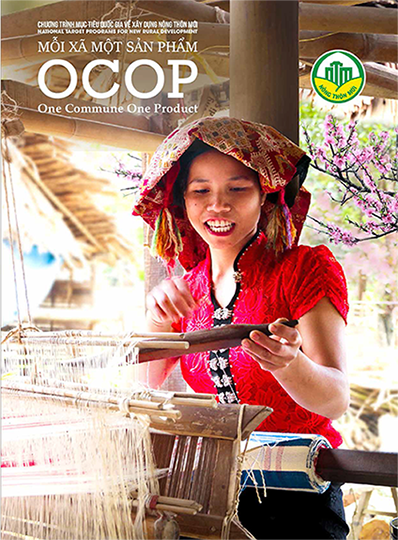Based on the international experience and initial success of some provinces, at the National Conference on OCOP Program (March 2017 in Quang Ninh), Prime Minister Trinh Dinh Dung directed Ministry of Agriculture and Rural Development to coordinate with related ministries and sectors to prepare a proposal on expanding OCOP model on national scale.
The result of OCOP is expected to be the development of the integrated production of local agricultural and non-agricultural specialties in the rural area, the increase in social interest for rural residents, many agricultural brands formed. The development of OCOP not only brings along the production development, but also helps resolve major issues of rural areas such as poverty reduction, labor restructuring and unemployment, etc.
Agricultural products that have competitive advantage of each province
The 2016 statistical report, the export turnover of agro-forestry fishery products hits 32.1 billion dollars making up 18% of GDP and 7.5 billion dollars in trade surplus. Many top products in production worldwide reach high export turnover in the global market such as coffee, cashew nut, pepper, seafood, etc. Moreover, many local key products also have good achievements. However, in general, their added value, price and market are still at a disadvantage, and also the production and distribution still remain passive.
Recently, in order to prepare the Proposal on the National OCOP Program, Ministry of Agriculture and Rural Development has conducted a nationwide survey. According to brief report of provinces, currently our country has 4,736 agricultural products having competitive advantage and belonging to 6 product groups (Food group: 2,516 products - 53.1%; Beverage group: 1,039 products - 21.9%; Herb group: 231 products - 4.9%; Fabric and Textile group: 186 products - 3.9%; Souvenir, Interior Furniture, Decoration group: 573 products - 12.1%; Service and Rural Tourism group: 191 products - 4%). Among those products, there are 954 products (20.1%) registered for quality publicity, 581 products (12.4% of total currently existing products) registered for intellectual property protection.
However, these products’ main market still stays in their province. Only a few products are distributed to other province, and fewer ones are qualified for export (mainly handicrafts). The value chain, distribution system, market, etc. are also facing many problems.
Product development in OCOP model
To conquer both domestic and global market, Vietnamese products need improvement in quality, package, distribution and after-sales service. Enterprises and producers also need to enhance their capacity in administration, management and technology application to production. At the same time, farmers need developing into their own economic organization (small and medium enterprise, cooperative, cooperative group) so that they can be confident to own the situation and their business, and actively play their part in developing local competitive advantages.
Based on the experience of other countries, OCOP Program is required to implement in (1) Develop OCOP Program in both width and depth following 3 principles of the global OVOP (Local yet global; Self-reliance and Creativity; Human Resource Development); (2) Organize specialized activities yearly so as to take advantage of traditional/local and cultural products of each province, resolve fundamental issues of OCOP development following the experience of Thailand; and (3) Link with the activities of the Building new-style rural areas program at district and commune level, take this as one of the key solutions to implement the New-style rural areas program.
Moreover, this is an economic development program suitable for the current regional economic development state of both rural and urban areas. Therefore, this program will not be narrowed in rural areas.
Trade promotion for products of OCOP Program
Based on Decision No. 2277/QĐ-BNN-VPĐP dated June 5th 2017, Ministry of Agriculture and Rural Development decided to conducted a nationwide survey in order to prepare a draft for the National Project. Basically, the process of OCOP comprises 6 steps from diffusion to product development and trade promotion.
On the aspect of value chain, trade promotion needs attention from the very first step because “consumer” is the one deciding the chain. The target that trade promotion in value chain development and OCOP product development should focus on is consumers as they have a tendency to keep setting the bar for price, quality, product appearance and support services higher and higher.
From the experience of other countries, it is found that trade promotion through OCOP needs to focus on (1) product endorsement; (2) E-commercial; (3) organizing trade fairs, exhibitions; and (4) infrastructure, introduction and sales system for OCOP products (e.g. OCOP center at district, commune and national level, OCOP stall at supermarkets, traditional markets; product displays at hotels, restaurants, administrative center, etc.).
From September 1st to 5th 2017, for the very first time, Ministry of Agriculture and Rural Development in collaboration with Quang Ninh Province organized OCOP trade fair at a national scale. According to the data provided by the Organizing committee, currently there were almost 40 provinces and cities showcasing their local and regional products at the fair. Several services company (package printing, administration, intellectual property, technology) and some countries (Korea, Thailand, Laos, China) also took part in this traide fair. Besides, not only did they showcase their products, many provinces and cities also sent their officials, staff, representatives of local enterprises, cooperatives to this fair to observe and adopt experience from Quang Ninh.
As one of the activities of the trade fair, the Central Coordination Office of New-style rural areas organized a conference on ways to promote trade in OCOP model. This fair is considered “a draft” for the organization of a national trade fair in the future.
Source: Nong Nghiep Viet Nam




